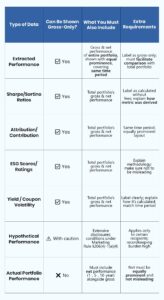On March 19, 2025, the SEC dropped an update that compliance officers have been waiting for since the Marketing Rule’s enforcement wave began. The new FAQs target the thorniest part of the rule: performance data. It’s not a sweeping rewrite. It’s a set of high-stakes clarifications—delivered with language that should make any adviser’s legal team sit up straight. After months of conflicting interpretations, cautious marketing revisions, and a few public enforcement bruises, the SEC has now carved out specific scenarios where performance data can be used. These uses no longer put firms at immediate risk of scrutiny, but that kind of clarity comes with conditions. And compliance just got more nuanced.
A Rule Decades in the Making
The SEC’s marketing regulations didn’t always have this level of granularity. The original Advertising Rule was introduced in 1961, back when marketing meant glossy brochures and in-person pitchbooks. By 2020, the Commission overhauled it, replacing outdated language with a unified Marketing Rule under Rule 206(4)-1 of the Investment Advisers Act. That rule took full effect in November 2022. Enforcement didn’t wait long to follow. The first public actions (like Titan Global Capital’s penalties for misleading hypothetical performance) hit fast and hard. Since then, firms have scrambled to decode what qualifies as “fair and balanced.” This FAQ update reflects the SEC’s response to mounting industry questions—and compliance stumbles.
The Two Big Clarifications
The new guidance addresses two central pain points: extracted performance and portfolio characteristics. Here’s what you need to know.
Extracted performance
Advisers may now present gross performance of an investment or strategy segment—without a net counterpart—if all of the following conditions are met:
- Extracted performance is clearly labeled as gross.
- The gross and net performance of the total portfolio is shown alongside it.
- That total portfolio performance is equally prominent and easy to compare.
- The time period shown matches across the extracted and total portfolio data.
This removes a major hurdle for firms using strategy-level data or sub-portfolio returns in their materials. But it does not lessen the documentation burden. Advisers must still prove that all of the above conditions are met in every use case.
Portfolio characteristics
The SEC also clarified whether certain metrics—like Sharpe ratios or volatility—count as “performance.” Short answer: not always. These characteristics can be shown gross only if:
- The characteristic is clearly disclosed as not net of fees/expenses.
- It is shown alongside total portfolio gross and net performance.
- That portfolio performance is prominent and aligned in time period and context.
- A brief explanation of how the characteristic is calculated is included.
This guidance acknowledges that performance-related stats are often critical to understanding risk or return—but the SEC still expects them to be contextualized within the total portfolio.
Guidance ≠ Grace
The FAQ uses one phrase repeatedly: “the staff would not recommend enforcement action.” This isn’t a green light—it’s a warning label. The burden of interpretation remains on the adviser. Staff won’t hold your hand through close calls. They’ve simply shown you where they’re more likely to bite.
The Extracted Performance Trap
Before this FAQ, extracted performance was one of the riskiest areas of the rule. Firms hesitated to use it because they couldn’t calculate net returns for partial strategies—or feared the SEC would argue their comparisons were misleading. Now, there’s a narrow route forward. But the SEC has made it clear: extracted performance must be presented with airtight disclosures, timing alignment, and matching full-portfolio returns. One misstep, and it’s an enforcement case waiting to happen.
Performance or just a characteristic?
Risk-adjusted return metrics, attribution breakdowns, and even contribution-to-return data aren’t “performance” in the strict sense. But they do influence perception. That’s why the SEC’s tolerance hinges on context.
Examples of characteristics that can be shown gross-only (with proper framing):
- Sharpe and Sortino ratios
- Sector attribution
- ESG scores
- Yield and coupon rate
- Contribution to return
But only if accompanied by
- Total portfolio gross and net performance
- Equal visual prominence
- Methodology explanation
Slipping these metrics into a deck without those guardrails? Still very much a compliance risk.
Gross vs. Net: Solving the Presentation Puzzle
One of the most common errors in performance marketing is in the layout. Advisers often show 1-year, 5-year, and 10-year net returns but bury them after multiple slides or present them in small font, far from the associated gross data. The FAQ reinforces that
- Required periods (1-, 5-, and 10-year) must be shown for net returns when relevant.
- Gross and net must be shown with equal prominence.
- Side-by-side presentation is safest.
- Sequential layouts are acceptable—but only if the net returns aren’t de-emphasized.
A tiny footnote isn’t going to cut it. Net returns need to be just as visible and digestible as their shinier gross counterparts.
Pro Tip
Equal prominence ≠ same font size only. Net returns must be just as visible, accessible, and understandable as gross data—no burying in footnotes.
What Firms Should Do Now
To avoid scrambling later, investment advisers should take concrete steps now. Here’s where to start:
- Re-audit all performance advertising and fact sheets for extracted or characteristic data.
- Create or update an internal memo explaining when and how gross-only performance is allowed.
- Revise templates so total portfolio performance always appears when needed—clearly and visibly.
- Train client-facing teams and marketers on the difference between characteristics and performance.
Optional: develop a compliance checklist or insert auto-review rules into pitch deck templates to reduce manual oversight.
Conclusion — Clarity, With an Edge
The SEC’s FAQ update doesn’t change the law, but it changes the temperature. Advisers now have clearer outlines, but they still carry risk. The regulators have drawn lines, not erased them. The regulators are showing where they’re watching most closely. For firms that take shortcuts, this update doesn’t soften the blow: it sharpens the aim.
Summary Table: What the SEC’s 2025 FAQ Says You Can Show—And How to Do It Right



